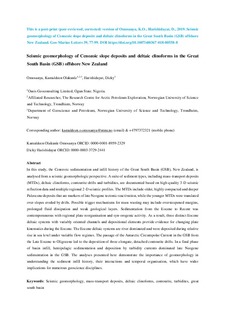| dc.contributor.author | Omosanya, Kamaldeen Olakunle | |
| dc.contributor.author | Harishidayat, Dicky | |
| dc.date.accessioned | 2019-12-02T13:45:16Z | |
| dc.date.available | 2019-12-02T13:45:16Z | |
| dc.date.created | 2019-01-09T20:27:33Z | |
| dc.date.issued | 2019 | |
| dc.identifier.citation | Geo-Marine Letters. 2019, 39 (1), 77-99. | nb_NO |
| dc.identifier.issn | 0276-0460 | |
| dc.identifier.uri | http://hdl.handle.net/11250/2631290 | |
| dc.description.abstract | In this study, the Cenozoic sedimentation and infill history of the Great South Basin (GSB), New Zealand, is analysed from a seismic geomorphologic perspective. A suite of sediment types, including mass-transport deposits (MTDs), deltaic clinoforms, contourite-drifts and turbidites, are documented based on high-quality 3-D seismic reflection data and multiple regional 2-D seismic profiles. The MTDs include older, highly compacted and deeper Palaeocene deposits that are markers of late Neogene tectonic reactivation, while the youngerMTDs were translated over slopes eroded by drifts. Possible trigger mechanisms for mass wasting may include oversteepened margins, prolonged fluid dissipation and weak geological layers. Sedimentation from the Eocene to Recent was contemporaneous with regional plate reorganisation and syn-orogenic activity. As a result, three distinct Eocene deltaic systems with variably oriented channels and depositional elements provide evidence for changing plate kinematics during the Eocene. The Eocene deltaic systems are river-dominated and were deposited during relative rise in sea level under variable flow regimes. The passage of the Antarctic Circumpolar Current in the GSB from the Late Eocene to Oligocene led to the deposition of three elongate, detached contourite drifts. In a final phase of basin infill, hemipelagic sedimentation and deposition by turbidity currents dominated late Neogene sedimentation in the GSB. The analyses presented here demonstrate the importance of geomorphology in understanding the sediment infill history, their interactions and temporal organisation, which have wider implications for numerous geoscience disciplines. | nb_NO |
| dc.language.iso | eng | nb_NO |
| dc.publisher | Springer Verlag | nb_NO |
| dc.relation.uri | https://link.springer.com/article/10.1007/s00367-018-00558-8 | |
| dc.subject | Paleoseanografi | nb_NO |
| dc.subject | Paleoceanography | nb_NO |
| dc.subject | Tektonikk | nb_NO |
| dc.subject | Tectonics | nb_NO |
| dc.title | Seismic geomorphology of Cenozoic slope deposits and deltaic clinoforms in the Great South Basin (GSB) offshore New Zealand | nb_NO |
| dc.type | Journal article | nb_NO |
| dc.type | Peer reviewed | nb_NO |
| dc.description.version | acceptedVersion | nb_NO |
| dc.subject.nsi | VDP::Sedimentologi: 456 | nb_NO |
| dc.subject.nsi | VDP::Sedimentology: 456 | nb_NO |
| dc.source.pagenumber | 77-99 | nb_NO |
| dc.source.volume | 39 | nb_NO |
| dc.source.journal | Geo-Marine Letters | nb_NO |
| dc.source.issue | 1 | nb_NO |
| dc.identifier.doi | 10.1007/s00367-018-00558-8 | |
| dc.identifier.cristin | 1653637 | |
| dc.description.localcode | This is a post-peer-review, pre-copyedit version of an article published in [Geo-Marine Letters] Locked until 9.1.2020 due to copyright restrictions. The final authenticated version is available online at: https://doi.org/10.1007/s00367-018-00558-8 | nb_NO |
| cristin.unitcode | 194,64,90,0 | |
| cristin.unitname | Institutt for geovitenskap og petroleum | |
| cristin.ispublished | true | |
| cristin.fulltext | postprint | |
| cristin.qualitycode | 1 | |
